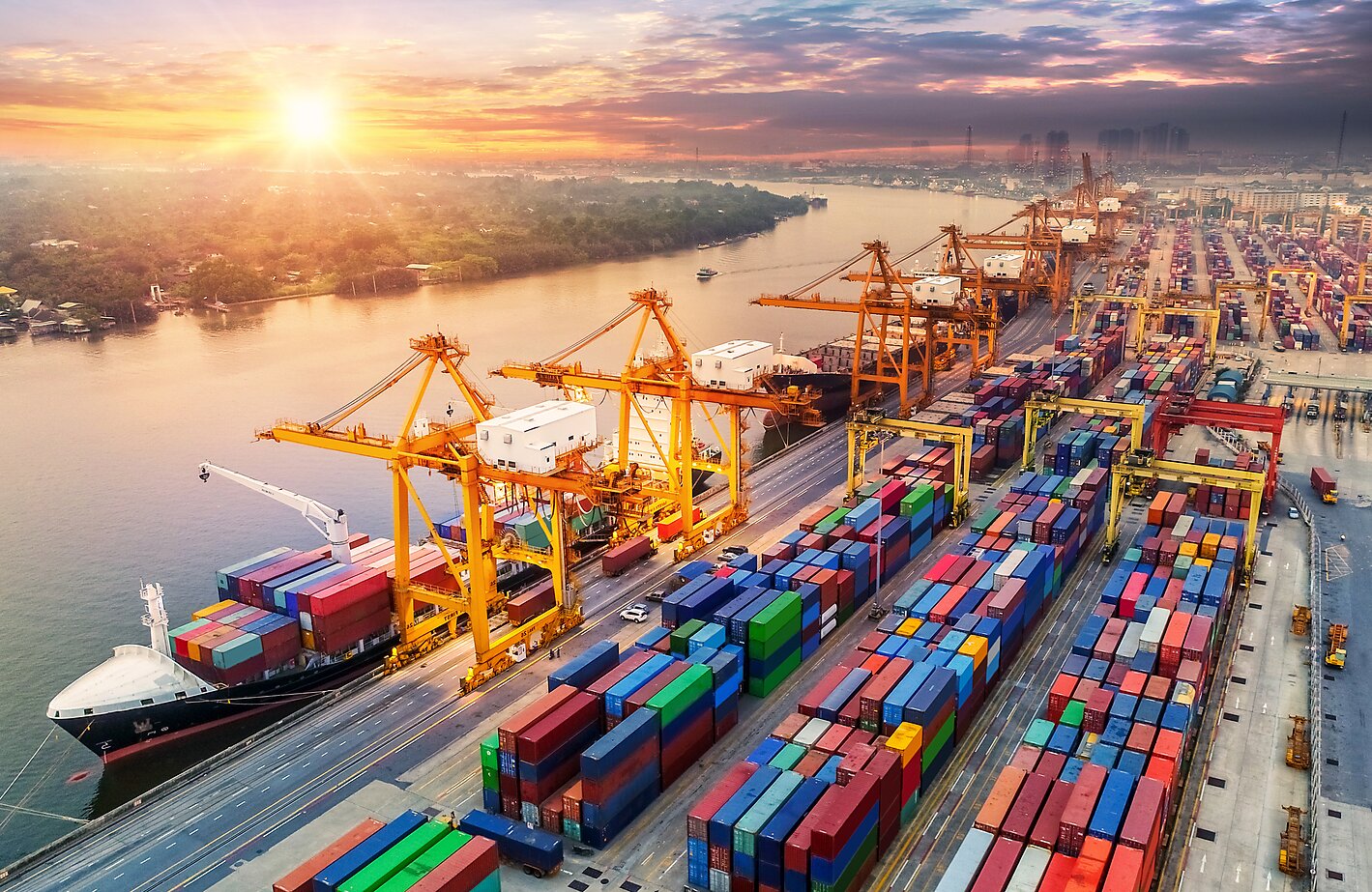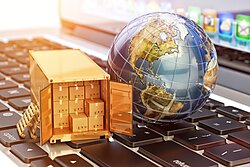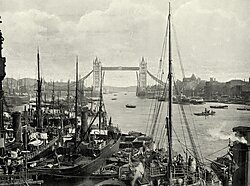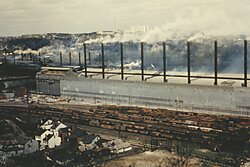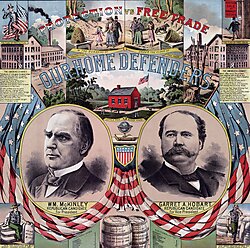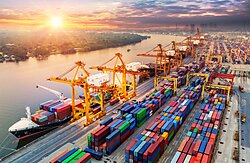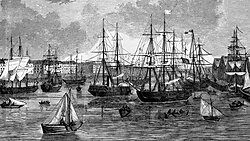-
Discussions of globalization typically focus on the role of government policy in facilitating cross-border trade and investment, yet private-sector innovation has also driven these same trends.
-
Containerization has been a key contributor to these lowered costs. By offering vastly more efficient loading and unloading of goods as well as greater protection against pilferage and damage, containers have significantly expanded international trade.
-
Efficiency gains in air freight resulting from technological improvements have similarly produced significant cost reductions. Although air freight moves only a small percentage of international trade by weight, it plays a critical role in the transportation of high-value goods.
-
Advances in computers and telecommunications have also encouraged international economic linkages, allowing businesses and customers to connect more easily across distances and borders and providing the data processing heft necessary to track and organize shipments across increasingly complex supply chains.
Private Initiatives Help Drive Cross-Border Trade
Discussions around globalization may create the impression that expanded cross-border economic ties have been solely a policy choice or the result of coordinated efforts by governments around the world. That’s not surprising, as governments have used both unilateral and coordinated multilateral efforts to significantly reduce obstacles to cross-border trade in the post–World War II era. As a result, the average value of tariffs in force around the world has declined by 85 percent since 1947, and many nontariff barriers have been reduced or eliminated. This policy liberalization correlates with international trade as a percentage of world gross domestic product more than doubling from 25 percent in 1970 to 57 percent in 2021.
Often overlooked, however, is the role of private initiatives that have encouraged cross-border trade. Although engendering far less acrimony—there have been no protests against more efficient shipping or plunging costs in information technology—their impact has been undeniably significant. Indeed, the reduction in transportation and communication costs resulting from private innovation have been of such magnitude that supply chains can now be weaved among specialized firms in numerous countries.
The numbers speak for themselves. According to a 2023 paper, transport costs by weight declined by 33–39 percent from 1970 to 2014, while transport costs by value declined 48–62 percent. Other measures indicate that ocean shipping, which carries around 80 percent of international goods trade by volume, saw costs decline by just over 50 percent from 1974 to 2016, while air cargo costs fell 78 percent from 1970 to 2019.
These advances have made the world dramatically smaller and more prosperous than what many perhaps believed possible. This paper will take a closer look at some of the technological drivers that have advanced globalization by making trade cheaper and easier than ever before.
Containerization Has Significantly Reduced the Cost of Transporting Goods
Perhaps no innovation has done more to promote international trade and globalization in the modern era than the humble shipping container, which is responsible for roughly 35 percent of global merchandise trade by volume and over 60 percent by value. Typically constructed in lengths of 20 or 40 feet, containers greatly ease the loading and unloading of ships, as giant cranes transfer the boxes from ship to shore (or the reverse) in about two minutes. From there they can be either trucked to local warehouses to be unpacked, transferred to smaller vessels for transshipment to other ports, or placed on trucks and railroads to be transported closer to their final destinations.
Although the concept of placing items in containers for easier transport has been around since at least the 18th century, such efforts did not spread beyond niche applications. Succeeding where others failed and ushering in the modern era of containerization was Malcom McLean, the owner of a large trucking company. Although accounts of McLean’s foray into container shipping differ—some cite his desire to bypass traffic, while others emphasize his desire to avoid government meddling in interstate trucking—the trucking industry veteran originally conceived of using ships to transport truck chassis and containers together. He soon realized, however, that loading the containers alone would be a more efficient means of transport that allowed for stacking.
McLean’s vision was realized on April 26, 1956, when a World War II–built tanker called the SS Ideal X departed Port Newark, New Jersey, for Houston. Cheaply acquired thanks to a government maritime promotion program, the vessel had been modified to transport 58 containers on a spar deck above the tanker piping. Although a visual oddity, the ship made clear containerization’s compelling economics. While the loading of cargo in piecemeal fashion prior to the advent of containers was estimated to cost $5.83 per ton in 1956, the Ideal X was able to reduce that figure to $0.16 per ton—a 97 percent decrease. In Box Boats: How Container Ships Changed the World, author Brian J. Cudahy calculates that the cost to unload a conventional cargo ship was at least $15,000, whereas the Gateway City, another container ship operated by McLean, could be unloaded for $1,600—an 89 percent decline.
To encourage its adoption, McLean allowed others access to his patented standardized container designs through a royalty-free lease to the International Organization for Standardization. The shipping industry was forever changed.
Containerization’s dramatic reduction in cargo handling costs reflected a vast increase in port productivity: from 1965 to 1970, the amount of cargo that could be moved by stevedores onto a ship increased from 1.7 tons per hour to 30 tons per hour. According to Box Boats, whereas previously a cargo ship required 150 stevedores working at least four days to load and unload, a crew of 14 could do the same task on the Gateway City in just over eight hours.
Less time loading and unloading meant that ships could spend more time sailing, boosting their own productivity and more quickly speeding goods to market. A 1985 comparison between the container ship Liverpool Bay and the cargo ship Priam, which was not specially designed to transport containers, found that the former spent 17 percent of its time in port compared with 40 percent for the latter. Cudahy writes that, prior to containerization, it was “not uncommon for a vessel assigned to the busy transatlantic trade route between New York and the channel ports of Europe to spend as much time in port loading and unloading cargo, over its lifetime, as it did steaming across the ocean.”
Containers also provided other benefits, such as deterring pilferage, by making the cargo less accessible (recalling his stint on a merchant ship prior to widespread containerization, author Christopher Buckley noted that “you knew what cargoes you were carrying because you could see them, smell them, touch them, and on occasion, help yourself to them,” while the wages of New York dockworkers were jokingly said to be “twenty dollars a day and all the Scotch you could carry home”). Increased ease of cargo handling also meant fewer damaged goods, which, along with reduced thievery, resulted in reduced insurance costs. As one example, shipping between Australia and Europe saw insurance costs fall from an average of $0.24 per ton to $0.04 per ton from 1965 to 1971.
Containerization had profound implications not only for ships but for transportation more broadly, as cargo could now be easily transferred among various modes, including trucking and rail. The modern era of intermodal freight transport was born and the entire transportation system revolutionized.
Efficiency Gains in Shipping Have Also Contributed to Lower Transportation Costs
Beyond containerization, another contributor to the lower transportation costs that have helped make globalization possible is the increased efficiency of the ships transporting these containers. The scale of their increase in size is almost mind-boggling. While the SS Ideal X carried 58 containers that were each 35 feet long, specialized container ships today regularly transport thousands of containers. The largest of these oceangoing behemoths, a ship called the MSC Irina, can carry 24,346 units that are each the size of one 20-foot container—enough to transport over 12,000 boxes that are 40 feet each. For perspective, the smaller MSC Oscar’s capacity of 19,224 units that are 20 feet each is sufficient to carry 39,000 cars, 117 million pairs of sneakers, or over 900 million cans of dog food.
More boxes per ship leads to lower shipping costs, as fixed costs are spread across more containers. Although there is a debate over the optimal size of container ships, particularly given the extra money that must be spent on port facilities to accommodate these oceangoing giants, there is little question that today’s container ships are more efficient than those of decades past.
This trend toward larger vessels goes beyond container ships. In 1950, the Bulkpetrol was launched as one of the world’s largest tankers capable of transporting over 50,000 tons. Nine years after that, a tanker of over 100,000 deadweight tons was launched, and by 1966, the first very large crude carrier was launched at over 200,000 deadweight tons. The year 1968, meanwhile, saw the launch of a tanker whose capacity exceeded 325,000 deadweight tons. Bulk carriers used to transport dry cargo, such as large amounts of grains or coal, have also seen considerable growth in size.
But the ships have become not only larger but also more efficient, using automation to significantly reduce the number of crew members. The Priam, for example, launched in 1966, featured a crew of 43, while the crew size of modern container ships averages around 22. Some large cargo ships today feature as few as 13 crew members.
Other developments have produced efficiency gains as well. Shipping giant Maersk’s introduction of its Triple‑E (economy of scale, energy efficiency, and environmental impact improvement) class of ships, for example, relied on a combination of factors, including size, technological refinements, and the use of more efficient slow steaming to reduce its shipping costs by $300–$400 per container.
Beyond technological factors, new means of managing and operating the ships have also contributed to lower costs. Open registries, for example, allow ships to sail under the flag of a country even when there is no link between the vessel—such as the owner or citizenship of the crew—and the country whose flag it flies. Such flexible arrangements allow for ships to be crewed with highly trained mariners from countries such as the Philippines and India that have lower wage demands than mariners from the United States or other highly developed countries.
Countries operating these open registries also typically have lower taxes than elsewhere, further contributing to lower costs. Such arrangements increased the percentage of the global fleet flagged in open registries from 21.6 percent in 1970 to 71.3 percent in 2015. Notably, a number of the leading open registries are also known for their quality, with countries such as Liberia and the Marshall Islands enjoying a better ranking than the United States.
Efficiencies and lowered costs beget more trade, which leads to further efficiencies. Expanded cargo volumes allow for the use of larger ships as well as increased competition as more firms enter the market, both of which serve to restrain costs. Growing trade also promotes the development and utilization of more efficient and specialized vessels, such as the Toyota Maru No. 10, which in 1970 became the first vessel developed solely to transport cars. There are also ships specialized for transporting vast quantities of fruit juice. Specialized ships have even been built for moving other vessels, such as the Blue Marlin, which was once used to transport 22 barges from South Korea to the Netherlands.
All these factors have combined to produce significant drops in the cost of ocean transportation. While in 1890 it cost nearly $200 per ton (2020 dollars) to ship goods from California to Europe, that figure had declined to less than $2 per ton using a standard bulk ship a century later. Today, T‑shirts can be transported from China to the Netherlands for $0.025 per garment, and Nike shoes can be shipped over similar distances for just $0.35 per pair.
More-Efficient Airplanes Have Reduced the Cost of Moving Goods and People
Like sea transport, air cargo has experienced dramatic cost reductions that have contributed to the growth of international trade. Air cargo’s increased efficiency, however, is less the story of a single key innovation, such as the shipping container, and more the result of numerous smaller improvements that had a large cumulative impact. However, the jet engine’s thrust and fuel costs—as well as fewer moving parts—were one of the more significant contributions. Since its introduction, such engines have been steadily refined to become even more efficient.
In addition to engine enhancements, airplanes have also seen improved designs and the use of lighter composite materials that lower operating costs. Their collective impact has been impressive: from 1968 to 2014, the average fuel usage of new aircraft declined by approximately 45 percent. Such cost reductions have contributed to a dramatic increase in air transport’s role in international trade. Having once accounted for only 8.1 percent of US imports and 11.9 percent of US exports as measured by value in 1965, air cargo had surged to 31.5 percent of imports and 52.8 percent of exports by 2004.
Beyond increasing quantity, lowered costs also allow air cargo to travel farther. While air-shipped cargo averaged 2,600 miles in 1975, by 2004 that number had increased to 3,383 miles.
The iPhone provides an example of air freight’s compelling economics and the distances many goods now travel. In 2013 it cost approximately $242,000 to charter a Boeing 777 to transport 450,000 iPhones from China to the main US distribution facility, or less than $2 per phone. For context, that amounts to approximately 0.3 percent of the $649 starting price for the iPhone 5S released that same year.
Notably, increased air freight efficiency has contributed to supply chain resiliency. During the COVID-19 pandemic, numerous firms used aircraft to avoid congested ports and speed their products to market.
Besides increasing trade in physical goods, the plunging cost of air transport has also promoted tourism—another form of trade—and the international exchange of people. While 1980 saw 200 million international air travelers, by 2019 that number had surged to 4.6 billion, an 850 percent increase. Lowered costs have also had a democratizing effect. Passengers from lower‐middle‐income countries engaging in international air travel increased from 29 million in 1995 to 138 million in 2017—a 376 percent increase.
Improvements in Telecommunications and Computers Have Eased the Conduct of International Business
Several observers have identified advancements in computers and telecommunications as also playing a key role in the rise of globalization. The decline in cost of such services has been nothing less than astonishing. While the price of a three-minute phone call between New York and London was $75 in 1927—$469 in 2023 dollars—that number had shrunk to $2.77 by 1982 ($8.93 in 2023 dollars) and today essentially has no cost beyond the necessary hardware and monthly price of internet service. Computing, meanwhile, has been subject to Moore’s law, in which the information-processing capacity of microprocessors doubles every 18 months while cost falls at a similar pace. This combination of cheap computing and communication means that billions of phone calls, emails, video calls, and text messages are made or sent every day.
Besides the benefits that this connectivity brings to our everyday lives, it also helps smooth trade and ease the conduct of international business. According to historian and economist Marc Levinson, these technological leaps—along with efficient transportation over long distances—have provided large companies with the necessary tools to disperse production processes to those locations where they are best suited instead of keeping them in closer geographical proximity for ease of management.
In other words, factories can be set up where production is most efficient rather than being tethered closer to where company executives are located. Geoffrey Garret, currently dean of the University of Southern California’s Marshall School of Business, described a similar phenomenon in a 2000 essay:
The internet has radically reduced the costs of coordinating complex supply, production, and distribution networks that are geographically decentralized. The automobile industry is a classic example. It may long have been efficient for Volkswagen to buy gear boxes in the United States, build engines in Germany, assemble cars in Brazil, and sell the finished product cars all over the world. But the challenges of coordinating all this activity are immense, especially if Volkswagen wants to pursue just-in-time production/low inventory best practices. Being able to coordinate all elements of the supply and distribution chains on the World Wide Web has been a boon for firms that have incentives to decentralize their activities.
Economist and maritime transportation expert Martin Stopford, meanwhile, sees a connection between the advent of modern computing and containerization. In Maritime Economics, Stopford points out that containerization in its early days required large and expensive mainframe computers to handle associated tasks, such as tracking shipments and taking bookings. By the 1990s, such systems for running a container service had become significantly more advanced and efficient.
Technology has not only improved coordination but also allowed for expanded sales opportunities by more easily connecting businesses with consumers and other firms, including those in foreign markets. According to PayPal, 41 percent of online US shoppers purchase from abroad. In many countries, the number is even higher, with 76 percent of online consumers in Spain shopping abroad and 79 percent in Singapore. Another study, meanwhile, found that 96 percent of small and medium US enterprises using the e‑commerce platform eBay export to an average of 17 different foreign countries.
Being able to shop internationally and engage with suppliers at the mere click of a button has undoubtedly been yet another contributing factor to expanded economic interconnectedness.
Numerous Factors Help Drive Globalization Forward
Trade is the foundation of prosperity, allowing for greater levels of productivity as workers and firms become ever more specialized. A key factor in enabling this trade is efficient transportation and technologies that help overcome the distances that separate potential trading partners.
Such advancements are fundamental to today’s complex supply chains optimized for utilizing the comparative advantages of firms spread across the globe. Apple is a poster child of this phenomenon, relying on hundreds of parts from scores of suppliers spread across over 20 countries in fiscal year 2022. In 2019, Boeing relied on suppliers from 58 countries for the vastly complex aircraft it produces.
These companies are hardly alone in their use of cross-border trade to efficiently produce their products. Automotive firms have noted that vehicle parts and components may cross borders as many as eight times before reaching final assembly as they ping between those places with a unique specialization in each step of the process. It’s difficult to imagine this could take place without many of the innovations in transportation and technology developed over the past 50 years.
Cheaper transportation, powerful computing, and inexpensive access to world-spanning telecommunications services, however, hardly constitute the total sum of forces outside policy levers that have helped drive globalization forward. Indeed, they don’t even constitute the total sum of technological forces, with numerous other technologies helping to spur globalization, such as Universal Product Codes.
Interestingly, many of the forces that contribute to globalization outside the policy realm are in many ways outgrowths of globalization itself. The prosperity generated by increased trade, for example, leads to additional cross-border flows as consumers demand imported goods that were previously unaffordable. Consumers’ palates, for example, may evolve toward a taste for Italian prosciutto, cashmere from Mongolia, or high-end consumer electronics assembled in China (using inputs from numerous other countries). Globalization also creates more pathways to the types of employment that provide the disposable incomes for such purchases.
Notably, a 2001 paper calculated that income growth explains about 67 percent of the increase in world trade among several Organisation for Economic Co-operation and Development countries between the late 1950s and the late 1980s, while tariff-rate reductions are responsible for about 25 percent and transport cost declines thought to account for approximately 8 percent.
Globalization’s self-reinforcing nature may also apply to the way companies operate. As one paper notes, a “substantial fraction” of companies engaged in importing or exporting do both. This appears to suggest that companies develop a greater appetite for foreign markets as they become more familiar with global trade rules and more adept at navigating the red tape of importing and exporting after dipping their toes into international supply chains. Globalization, in other words, is in many ways a self-reinforcing cycle in which international trade creates yet more demand for the cross-border provision of goods and services.
But technology and innovation haven’t stopped, and even more new innovations could be on the way. Experiments with autonomous shipping are already taking place in Japan and Norway, and port automation projects in China, Singapore, and the Netherlands promise to bring a new era of efficiency to cargo handling. Such efforts could bring new efficiencies that further reduce the cost of transportation.
Advancements in telecommunications could also lead to new innovations and opportunities for trade. Ubiquitous internet connectivity, for example, has already ushered in the era of telemedicine, and technological leaps may be able to push the boundaries of such interactions still further to potentially include telesurgery. As technology advances and distances recede, exciting new possibilities await.
Innovators and the Technologies They Have Unleased Have Helped Drive Globalization
Since the earliest days of trade—which is to say, since the dawn of mankind—the ability to exchange goods has been limited by the proximity and visibility of potential trading partners. As new forms of technology—everything from the wheel to the caravel to the modern shipping container—have emerged to overcome these distances, trade has flourished, expanding the size of the market and enabling increasing levels of scale and specialization. The process of globalization is a long one and continues today as new innovations make it faster and easier for the world’s population to engage with each other. And humanity is all the better for it.
The path forward has, of course, been smoothed by wise policy changes of governments around the world. The reduction or outright elimination of tariffs and regulatory barriers to trade is a significant part of the globalization story. And, of course, there is still much more left to do, including policy reforms that would better allow Americans to take advantage of some of the technological advancements described in this essay. Cabotage restrictions in the US maritime and aviation markets result in increased costs and reduced connectivity that harm trade. Similarly, trade is hindered by underperforming US ports whose efficiency levels should be raised through targeted policy measures to match those of international peers.
But policy levers and changes are not the whole story—far from it. As impactful as the actions of lawmakers have been in driving cross-border exchanges, the work of innovators, such as Malcom McLean and myriad other engineers and businesspeople, has produced incremental, steady improvements to various technologies and has led to giant leaps in our ability to efficiently trade goods and services over vast distances. Globalization isn’t simply the choice of government officials but the realized aspiration of untold numbers of people whose work has steadily shrunk the world, expanded markets, and brought us closer together.

This work is licensed under a Creative Commons Attribution-NonCommercial-ShareAlike 4.0 International License.
